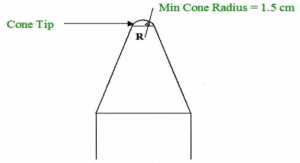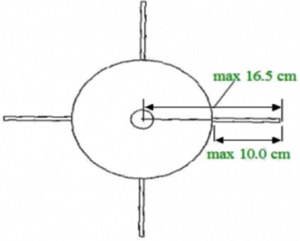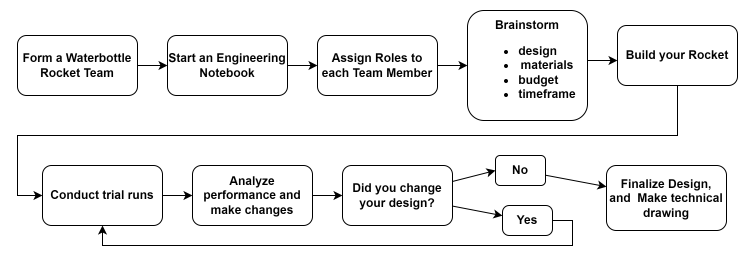Water Bottle Rocket Design Competition
Elementary Division
Competition Description – Elementary School Division
Get ready to unleash your creativity and engineering skills in the “Soar to Success” Water Bottle Rocket Design Competition! The Water Bottle Rocket Design Competition helps familiarize students with the fundamental engineering and design principles. SECME student teams will design and manufacture a Water Bottle Rocket using a clear two-liter bottle. The rocket must be propelled only by water and air. The winning rocket will have the greatest hangtime (maximum amount of time spent in the air) as measured in seconds.
Each SECME team is required to create an engineering notebook and a presentation as part of the design process.
>>>>>>> Water Bottle Rocket Design Guideline for Elementary School in PDF Format <<<<<<<
>>>>>>> Water Bottle Rocket Scoresheet in PDF Format <<<<<<<
Table of Contents
- Competition Requirements
- Process Map
- Engineering Notebook
- Presentation
- Submission Requirements and Scoring
Competition Requirements
Design Requirements
- The pressure vessel must be ONE clear two-liter bottle (NO tinted bottles allowed). See Diagram 1.
- Water and air pressure are the sole source of propellant.
- Leave 7.5 cm from the throat of the exit plane (bottom of the rocket) clear of any coverings (paint, markings, drawings, etc.). See Diagram 1.
- The maximum total height of the rocket is 76 cm; see Diagram 1.
- The Nose-cone tip must have a minimum radius of 1.5 cm; see Diagram 2.
- Fins may extend to the throat exit plane; see Diagram 2. (No forward-swept types of fins are allowed to be used on the rocket.)
- The bottle’s maximum fin width distance is 10 cm (or 16.5 cm from the center of the bottle axis). See Diagram 3.
- Parachutes are NOT allowed.
- The TOTAL cost of the water bottle rocket should not exceed $10.00
- Recycled and donated materials should NOT be included in the total budget, but DO show documentation of how you obtained the material
**The following materials cannot be used to construct your rocket. They are dangerous and could harm the operator and bystanders at launch.
- Metal, Glass, Hard plastics, Spikes, Antennas of any kind, and Rocks
**Click on each diagram to see the enlarged version.
| Diagram 1 | Diagram 2 | Diagram 3 |
 |
 |
 |
Rocket Launch and Hangtime Calculation
The launch angle, which can be adjusted from approximately 90 degrees (90º), will be kept the SAME for all rockets launched during a particular competition. Each rocket will be launched using 12 oz water at 70 psi of air pressure. The hangtime score will be determined using the following calculation:
![]()
- The hangtime is the time from when the rocket leaves the launch pad until it (or any part of it) reaches the ground or strikes an object. (This measurement will be taken using a stopwatch. If more than one judge is recording the time, the average of the judges’ times will be used as the team’s hangtime.)
- The max hangtime is the hangtime of the best-performing team recorded during the SECME Competition.
TOP >>>>>>>>>>>>>>>>>>>>>>>>>>>>>>>>>>>>>>>>
Process Map
TOP >>>>>>>>>>>>>>>>>>>>>>>>>>>>>>>>>>>>>>>>
Engineering Notebook
The SECME Engineering Notebook will allow your team to show all your hard work. Below, you will see the requirements for your team’s engineering notebook. The engineering notebook must be completed in a physical notebook, for example, a composition notebook.
Cover Page
- SECME Team Name
- Team’s Competition Type and Division
- Each team member’s name and grade
- School Name and District Name
- School City and State
- Name and Email of the team’s SECME coordinator
Table of Contents
- Include headings and page numbers.
SECME Team Norms and Team Roles
- Each team needs to create a set of Team Norms and Team Roles that should be placed directly after the table of contents.
- Team norms are a set of rules or operating principles that shape team member’s interactions.
- Create 5-10 team norms
- Example: Treat each team member with respect
- Team Roles should be assigned based on each team member’s strengths. Roles are based on 4 person teams. If your team has only 2 or 3 members, you can combine roles or double up as needed.
- Team Lead: This team member is responsible for overseeing the management of the project and its success. The team lead will make sure the team is on track to complete the project on time and under budget. They communicate with their coordinator/instructor for all questions and concerns.
- Scribe: This team member is responsible for keeping the Engineering Notebook up to date and taking any meeting notes. This person should have clear and legible handwriting. They also will need to communicate with each team member to collect information and work on the Engineering Notebook.
- Engineering Lead: This team member is responsible for maintaining the team’s original water bottle rocket design and creating any relevant technical drawings for the Engineering Notebook.
- Data Analyst: This team member is responsible for recording all data for the team’s original water bottle rocket and its trial runs. This includes the hangtime of the original design and/or any updated design. This team member is also responsible for recording the dimensions of the water bottle rocket and documenting the materials list. The data analyst will use the materials list to collaborate with the team lead on the budget.
**Note – Teams must consist of a minimum of 2 members and a maximum of 4 members
Brainstorm
- Include ALL ideas your team considered in the brainstorming process.
Concept Art/Sketches
- Include any preliminary sketches used in the developmental stages of your design process.
Materials and Budget
- Provide a list of materials used in your design.
- Include the cost of ALL materials EXCEPT recycled materials
- For recycled materials, include documentation of where your team obtained the materials.
- Include photos or copies of receipts for ALL purchased materials.
- Include the final cost of ALL materials.
Technical Drawings
- The team’s Technical Drawings are required to show the front, side, and top views of the design.
- Label all parts of the design.
- Label all relevant dimensions of the design (For example, Length, Width, or Height)
- Label all units in centimeters.
- The technical drawings can be hand drawn or created digitally using a CAD program.
- Ink pens, pencils, or markers may be used
Photos
- Include photos of the design’s front, side, and top views.
Trial runs
- Please include documentation of each trial run and notes/observations from each of the trial runs of the water bottle rocket design.
- Indicate which version of your water bottle rocket design you used for each trial run. (i.e., Trial Run – Design 1 – Test 1)
- Include ALL water bottle rocket design trial runs.
Meeting Notes
- Include ALL meeting notes for the Water Bottle Rocket design.
- ALWAYS include the DATE and TIME of each meeting for the Water Bottle Rocket Design.
TOP >>>>>>>>>>>>>>>>>>>>>>>>>>>>>>>>>>>>>>>>
Trial Runs
Your team will use hangtime to understand the performance of your water bottle rocket design. Your team will be able to use these data points to evaluate the effects of changes made to your water bottle rocket design. New trials must be documented each time a new design change is made to the rocket. Each water bottle rocket design requires a minimum of 3 trial runs. Each SECME team must complete and record a minimum of 6 trial runs of their water bottle rocket design in their SECME engineering notebook.
When documenting your water bottle rocket trial runs, follow the below instructions.
- Include hangtime (from launch until it lands on the ground)
- Include notes about the water bottle rocket’s performance.
- Include a hypothesis (or prediction) of what your team thinks will happen, given the new changes made by the team.
Additionally, your team will need to include a statistical analysis of your water bottle rocket’s performance. Include the following data from your team’s tests:
- Average time traveled from trial runs.

- t‾ is the average time traveled from trial runs measured in seconds.
- t is the time traveled from a trial run measured in seconds.
- n is the number of trial runs performed by the team’s water bottle rocket.
Presentation
The Presentation will allow your team to showcase your work in a presentation format. You may use the platform of your choice (PowerPoint, Google Slides, Canva, etc.) We hope that through this presentation, your team will be able to showcase further your design and all the hard work you have done. Please use the information below as a template for your presentation.
Title Slide
- SECME Team Name
- Team’s Competition Type and Division
- School Name and District Name
- School City and State
- Name and Email of the team’s school representative (coordinator or teacher)
About Your Team Slide
- Team Photo
- Team members’ names, grade levels, and team roles.
- Years involved with SECME
Brainstorm and Sketches
- Include the final ideas (you do not need to include all your ideas) that your team considered in the brainstorming process.
- Explain why you DID NOT use them in your final design
- Include any sketches you used in your brainstorming process
Drawings of the Final Design
- Include a photo of your sketch of the final design (this is NOT your technical drawing)
- Explain what you used from your brainstorming process and why you included it.
Materials list and Budget
- Provide a list of ALL materials used in your design and pictures of the materials.
- Include the cost of ALL materials EXCEPT recycled materials
- For recycled materials, include documentation of where you obtained it
- Include a photo of receipts for ALL purchased materials
- Include the final cost of all materials.
Technical Drawings
- The team’s Technical Drawings are required to show the design’s front, side, and top views.
- Label all parts of the design and explain their functionality
- Label all relevant dimensions of the design in centimeters (For example, Length, Width, or Height)
- Include a color photo of your water bottle rocket next to the technical drawing
Trial Runs
- Include the trial run data for your final design
Conclusions and Future Recommendations
- Provide your team’s conclusion on your design process and any recommendations you have to better your design in the future (For example, if cost were not a constraint)
TOP >>>>>>>>>>>>>>>>>>>>>>>>>>>>>>>>>>>>>>>>
Submission Requirements and Scoring
For detailed scoring, please download the Scoresheet.
- Final Hangtime of Rocket – 50%
- This score is determined based on performance at the regional competition.
- Engineering Notebook – 30 %
- The notebooks will be evaluated by judges at the competition. You must bring your physical notebook to receive a score.
- Presentation – 20%
- The presentation must be submitted as a PDF with the file name “SECME_WBR_Presentation_Elementary_Your School Name“.
TOP >>>>>>>>>>>>>>>>>>>>>>>>>>>>>>>>>>>>>>
** NOTE – Only Teams Proceeding to the National Competition!!!!
Teams who place 1st at their Regional Competitions and proceed to the National Competitions must submit a video recording of themselves presenting their design.
Please use the information below as a guide for your video recording.
- Introduction
- State your School Name, School City, School State, Team Name, and Competition Type/Division
- Introduce your team with your names and grade levels
- Engineering Notebook
- Please present and show all aspects of your engineering notebook
- Explain all aspects of your design and your design process
- Avoid reading directly from your Engineering Notebook
- Conclusions and Future Recommendations
- Provide any conclusions you have on your design process and any recommendations you have to better your design in the future (For example, if cost were not a constraint.
Expectations and Requirements
- ALL team members should be in their Video Presentation and have a speaking role
- The video should be between 5 and 7 minutes, in mp4 format, and with the file name “SECME_WBR_Video_Elementary_Your School Name.”

